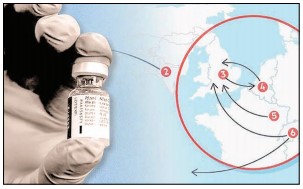By Ralf Peters and Divya Prabhakar, UNCTAD
COME summer, wealthy nations are beginning to return to normal, while the rest of the world continues the struggle to vaccinate its population. Many are eyeing the G7 countries, who are set to meet in June, to lead the way to vaccine equity. But two questions persist: why are vaccines not reaching everyone?
And what can we do about it? As the pharmaceutical powerhouse of the world and a key supplier of the COVAX initiative, India was poised to help a great number of developing and least developed countries by supplying COVID vaccines.
However, facing a catastrophic second wave itself, it has not only stopped exporting vaccines, but is now beginning to import them. The implications of this could be severe, particularly for poorer countries that were depending on India. The ripple effects would hit the most vulnerable countries the hardest, leaving them behind in the respective vaccination drives. 60% of vaccines for 20% of the population.
The WHO has already warned of a new wave in Africa, where vaccine imports have slowed down since India stopped exporting. But it is not just India. Other vaccine producing countries like the US and the European Union have imposed restrictions on exports of vaccines and critical raw materials needed for its production.
This is despite having already hoarded over 60% of the world’s vaccines before they were even approved for use. These developed countries comprise no more than 20% of world’s population. The production of vaccines is highly concentrated, mainly in a small number of higher and middle-income countries.
The necessary raw materials, too, are imported from only a handful of countries. The two top exporters of key ingredients, for instance, are the US and the EU – which account for half of total exports – followed by the UK, Japan and China, with significantly smaller shares.
This implies that restrictions on exports of vaccines or other critical raw material and equipment by even one or two countries can easily send shockwaves through the rest of the world, derailing the entire vaccine production and distribution effort, as we see at present.
Export restrictions are not exclusive to vaccines. Over 80 countries had resorted to banning exports of medical and personal protective goods in the early phases of the pandemic. This too had severe supply chain implications.
Nearly 60% of these curbs are still in place. Ultimately, these export restrictions may come back to bite the countries who imposed them.
As the virus continues to mutate, it may render vaccines ineffective and the already vaccinated less immune. The global economy, too, will not revive until everyone is vaccinated, since lockdowns and social distancing norms in key manufacturing locations continue to curtail global trade. Besides, this is a huge moral failure on the part of the global community.
A turning point?
The subject of export restrictions should be tackled at the WTO. The pandemic should serve as both a reference and a turning point. Reviving the debate around emergency export bans should form a key part of the WTO reform agenda.
The current rules allow for temporary export restrictions or prohibitions to prevent or relieve critical shortages of essential products, provided all measures are communicated, have phase out timelines and are proportionate to the scale of the problem at hand.
But who decides what constitutes proportionate, and what timeline is reasonable?
Export restrictions are sometimes seen as a necessary instrument to ensure popular acceptance of multilateral trade agreements.
The latter is important. However, open markets do not fit with sudden export restrictions during a pandemic. SOURCE: UNCTAD



